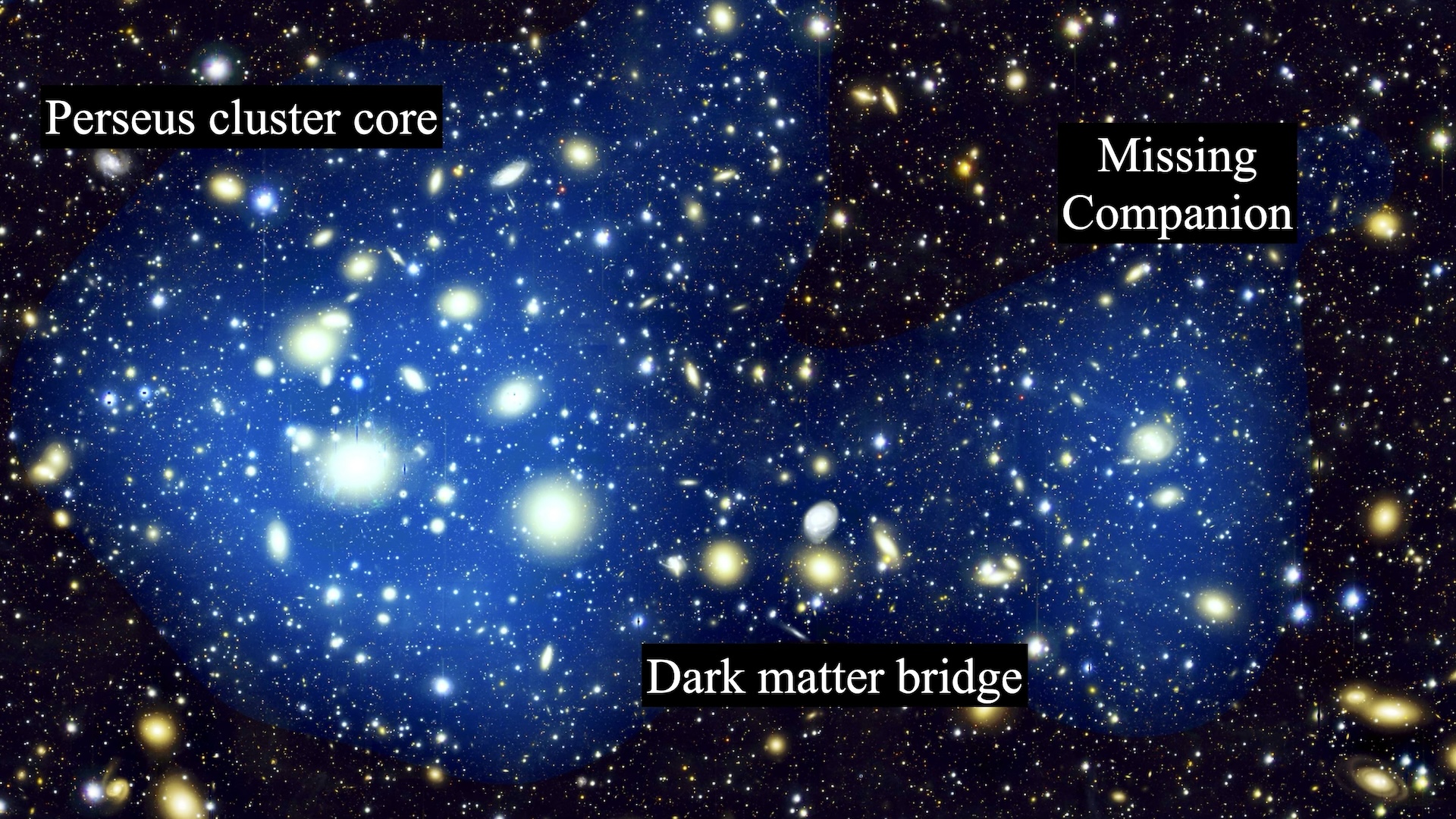
Astronomers thought the Perseus cluster was a massive-but-stable grouping of galaxies, until they found hints of a collision with another cluster — but no one had identified a cosmic interloper. Now, using a method called weak gravitational lensing, scientists think they’ve finally found the hidden intruder.
The Perseus galaxy cluster is one of the most massive structures in the known universe. Bearing the name of its host constellation, it’s a vast grouping of thousands of galaxies spread across 11.6 million light years, roughly 100 times the diameter of the Milky Way.
At 250 million light-years from Earth, it’s relatively nearby, though it’s moving away at 3,335 miles per second (5,366 kilometers per second) due to the expansion of the universe.
A ‘relaxed’ galaxy?
Astronomers call calm and stable galaxy clusters “relaxed,” which means they haven’t collided with other clusters in the recent history of the universe. For years, the Perseus cluster served as a prime example of a relaxed cluster.
Steady flows of hot gas move between its component galaxies and lose heat as the gas sinks toward the cluster’s center. There’s also a faint glow of radio waves, called a radio “mini-halo,” surrounding the central galaxy. Both are signs of a stable cosmic environment.
Yet astronomers noticed that instead of being spherical like an undisturbed cluster should be, it was lopsided in an east-west direction, hinting that something was amiss.
Related: Could the universe ever stop expanding? New theory proposes a cosmic ‘off switch’
Then, in 2012, astronomers spotted “cold fronts” in the cluster — huge, light-years-long regions that likely form when galaxy clusters collide. These fronts mark the boundary where hot gas from one cluster slams into cooler, denser gas from another. It was a strong clue that Perseus had been in a major cosmic crash. But if that was true, a question remained: Where was the other cluster that caused it?
‘Smoking gun’ evidence
In the new research, astronomers based in the U.S. and South Korea think they have found the “smoking gun” in the case of the clandestine cosmic collision. In a new paper published in the journal Nature Astronomy, the researchers explain how they used a technique called weak gravitational lensing to spot the remains of a cluster that collided with the Perseus galaxy cluster long ago.
Albert Einstein predicted the phenomenon of gravitational lensing over 100 years ago, whereby massive objects like galaxies would warp space-time, bending light rays and magnifying distant sources. The amount that an object deflects light gives astronomers a handle on its mass, and scientists have since discovered many incredible examples of gravitational lensing.
In weak gravitational lensing, the image of background galaxies is only slightly distorted as it passes through the cluster on its way to us. Using the Subaru Telescope in Hawaii, the astronomers in the new study analyzed the distortion of light from galaxies far behind the Perseus cluster.
“As we do not know the intrinsic shape of each galaxy, we cannot infer how much the image of the background galaxies are distorted,” HyeongHan Kim, a graduate student at Yonsei University in South Korea and first author of the paper, told Live Science in an email.
Yet, by viewing lots of background galaxies, the team worked out the average distortion and used a computer simulation to figure out the amount of mass in the foreground cluster. They also pinpointed where the mass had to be in order to produce the distortions they observed.
The astronomers discovered a vast region of both visible and dark matter, called a subcluster halo, surrounding a smaller grouping of galaxies. This region was centered on galaxy NGC 1264 and embedded in the outskirts of the Perseus cluster. About 100 times the mass of the Milky Way, the subcluster is linked to the main galaxy cluster by a “mass bridge” that is about 1.4 million light-years long and has almost the same mass.
The computer model suggested that this bridge is direct evidence of a gravitational interaction between the two clusters, rather than a chance alignment, and that it coincides with the lopsided shape of the cluster. The team’s computer model also re-created the cold fronts discovered in 2012.
“The result surprised me, because I considered Perseus to be a relaxed cluster,” Kim said.
Their simulation starts around 7.5 billion years ago, when the merging subcluster fell within the influence of the Perseus cluster. It took about 2 billion years for this subcluster to pass near the center of the main cluster for the first time. Then, slowed down and pulled back by gravity, it passed through again 3 billion years later. This cosmic dance repeated, and nearly 2 billion years later, the subcluster passed through a third time, roughly 750 million years ago.
The findings are significant because the region is a prime target for astronomers who are studying how galaxy clusters form and evolve.
“The Perseus cluster, thanks to its proximity, has been extensively investigated,” Kim said, “allowing us to discover and test many significant astrophysical processes.” So even though this study focuses on a single cluster, it has wide implications for our understanding of the universe, he added.
In addition, the results highlight the power of weak gravitational lensing, especially where traditional methods have failed to reveal the unseen universe. This approach not only helps to reveal hidden structures in the universe but also opens the door to discovering more galaxy-cluster mergers and to understanding how these massive systems take shape.
Premium IPTV Experience with line4k
Experience the ultimate entertainment with our premium IPTV service. Watch your favorite channels, movies, and sports events in stunning 4K quality. Enjoy seamless streaming with zero buffering and access to over 10,000+ channels worldwide.
















